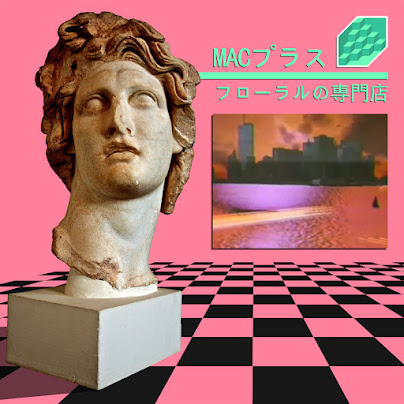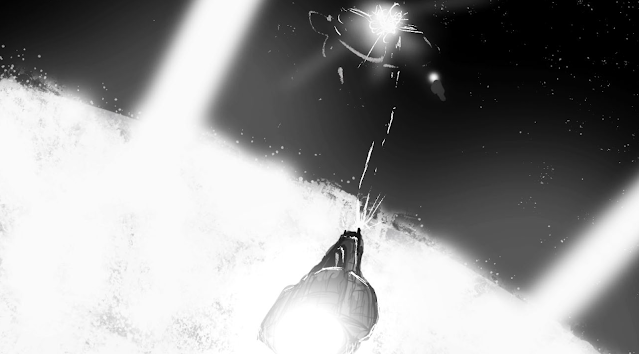The Consumerist Nostalgia Fantasy that is Vaporwave
 |
| A seminal classic. |
A washed-out pink background
with a black checkerboard sprawling out toward the horizon is juxtaposed with a
high-fidelity photo of the bust of Helios sitting in the foreground, while a
low-res image of a city skyline plays against the glistening ocean at sunset.
This eclectic mix
of imagery is the cover art for Vektroid’s Floral Shoppe (フローラルの専門店), released
under her one-time alias Macintosh Plus (MACプラス) on December 9th, 2011.
In 2014 this album,
in particular the song Lisa Frank 420 / Modern Computing (リサフランク420 / 現代のコンピュー), was propelled
to internet fame at the forefront of the emerging vaporwave genre. It took easy-listening
pop melodies, interlaced them with slow, stretched synths, cut and looped a
host of vocal samples, and released them out into the world of music in the
form of a lumbering aural Frankenstein.
And it was so fucking good.
_____________________________________________________________________________________________________________
Vaporwave
Vaporwave traces
its origins to chillwave and art pop, combining them with a cynical veneer of
post-irony that resonates with children of the 90's. It's an exploration of the
false nostalgia evoked within us from an era none of us lived in, while also
being a commentary on the throwaway consumerism of the twenty-first century.
Vaporwave is to music what pop art was to the visual arts.
It made its mark by taking on the remnants of other genres
and amalgamating them into a cornucopia of violet lights and echoing synths,
played against pop vocal samples that have become so ubiquitous as to be part
of the cultural framework of the modern West.
Vaporwave, as Floral Shoppe came to define, is music
designed to be ignored. It sits at the edge of your awareness, the half-forgotten
sounds of decades past played against each other fleetingly, never firm enough for
the conscious mind to firmly grasp. It pushes you out with banality only to
pull you back in, creating a trancelike state truer to the grind of daily life.
It's that grind that resonates most with young people
growing up in the throes of late-stage capitalism, where the happy veneer of 80’s
prosperity has been usurped by the slow, inexorable push for productivity in a
world now dominated by big data and machines.
The 80’s that never was
Vaporwave plays off
the tropes that come from the idea of the 80’s – the bright Pepsi
commercials, the palm trees swaying in the summer breeze, the revived notion of
the plaza and the rise of mall culture.
The genre itself,
however, takes these tropes and turns shows how hollow they are on their own
merits.
The musicality in
vaporwave, though not always aurally pleasing, exists to make a political point
on the destruction of humanity through consumerism and hyper-capitalism. It’s a
sardonic nod to the corporate propaganda pumped out in advertisements of every
shape, colour and size and plastered to the walls of shopping centres across
the world, exhorting us to buy, buy, buy.
The wry humour
behind much of the genre belies a critique of the world that stemmed from the careless
overconsumption of the 80s, and seems to argue for an accelerationist approach
as the only viable solution.
Vaporwave rapidly
extended out of music and into the visual to become an aesthetic that was
synonymous with mid-2010’s online culture. It became a jarring fusion of marble
statues and crude low-polygon 3D models set against backgrounds of neon, all
covered with artificial graphical artefacts and VHS blur.
And all of it was a
cry for help from a generation that never experienced the past, and felt as
though they would never experience the future.
 |
| Nothing says 'vaporwave' like Japanese script, crude 3D dolphins, and purple. |
The future that never came to be
Vaporwave drew on what
we wanted the 80’s to be – all neon purple, bright, brash, and offering an
optimistic vision of the future that never came to be.
It’s no surprise
that vaporwave consumers were predominantly born in the 90s, too late to
experience the gleaming promised land of aerobics exercise championships and retrofuturism,
and just in time to live through the Cambrian explosion of technology and a war
on terror.
Vaporwave follows in
the footsteps of other speculative fiction genres like raygun gothic or
atompunk, showing audiences what might have been. It was developed by a
generation that looked with longing at a time when the future must have still
seemed bright, and we would have hovercars by 2000, and maybe the world wouldn’t
become an Orwellian dystopia.
The aesthetic may
have lost its popularity as synthwave and mumble rap gained prevalence, but vaporwave
did something that not many genres have been able to accomplish – it merged the
angst and cognitive dissonance of an entire generation with the consumerist
fantasies peddled by megacorporate entities, and turned it into something
incredible.



Comments
Post a Comment